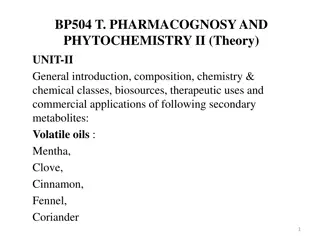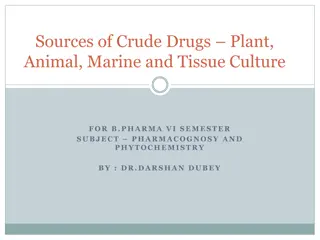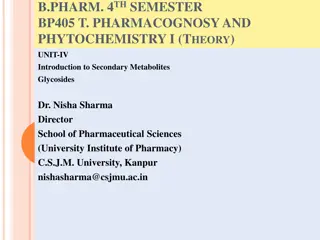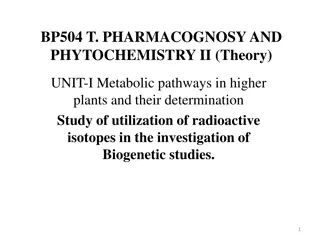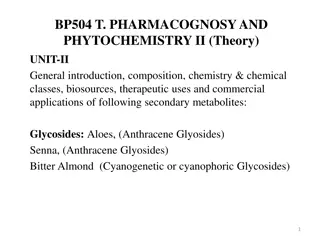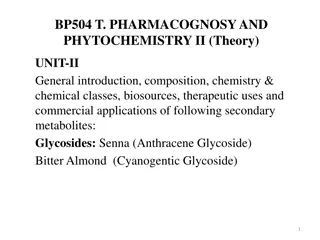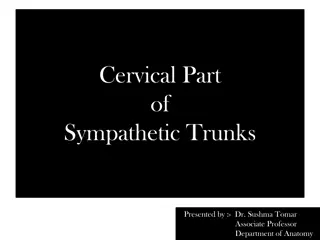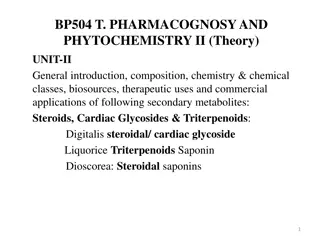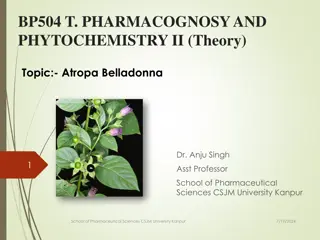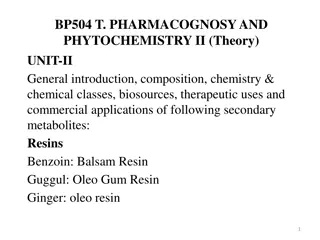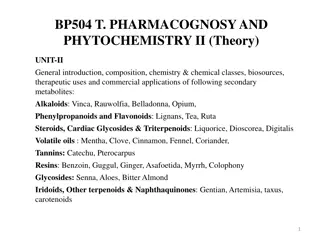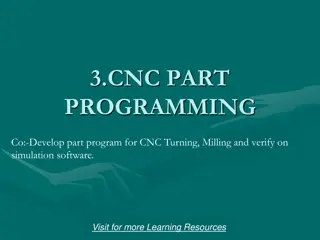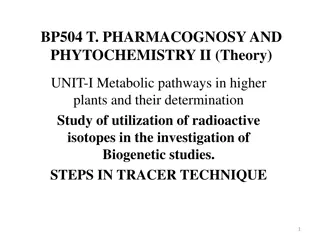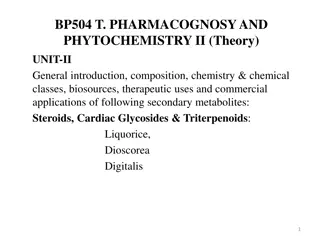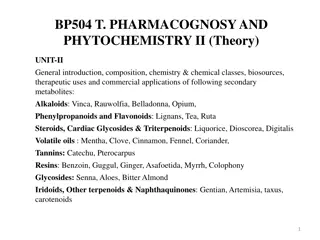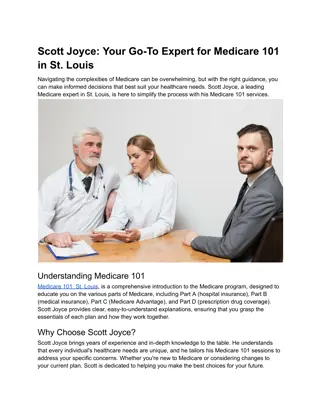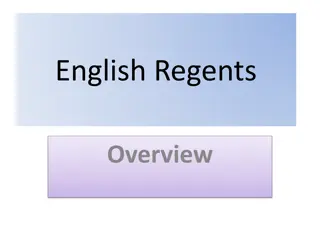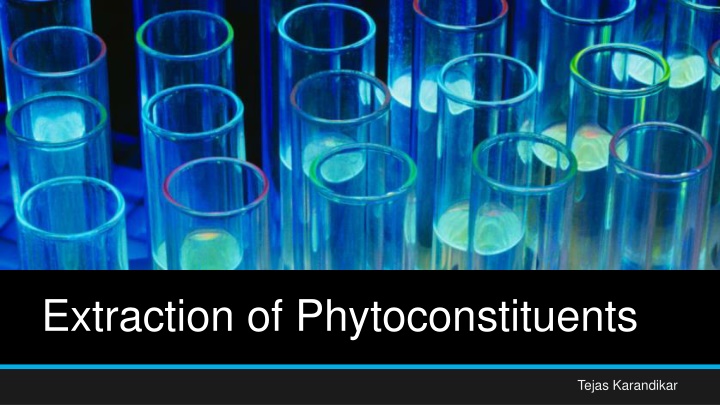
Phytoconstituent Extraction Methods and Solvent Selection
Learn about the extraction of phytoconstituents, the role of solvents, and methods like maceration and multiple-stage extraction for obtaining active compounds from plants. Understand the importance of solvent selection based on polarity and other properties to optimize the extraction process effectively.
Download Presentation

Please find below an Image/Link to download the presentation.
The content on the website is provided AS IS for your information and personal use only. It may not be sold, licensed, or shared on other websites without obtaining consent from the author. If you encounter any issues during the download, it is possible that the publisher has removed the file from their server.
You are allowed to download the files provided on this website for personal or commercial use, subject to the condition that they are used lawfully. All files are the property of their respective owners.
The content on the website is provided AS IS for your information and personal use only. It may not be sold, licensed, or shared on other websites without obtaining consent from the author.
E N D
Presentation Transcript
Extraction of Phytoconstituents Tejas Karandikar
Definitions Extraction:- Process of isolation of soluble material from an insoluble residue which may be liquid or solid, by treatment with a solvent. Solvent:- A solvent is a substance that dissolves a solute to form a solution. Phytoconstituents:- The medically/therapeutically active chemical compounds/molecules present in a plant are known as phytoconstituents or phytochemicals.
Choice of Solvent/s for extraction of Phytoconstituents The choice of solvent/s for extraction of phytoconstituents are based on the polarity of the phytoconstituent to be extracted. Since phytoconstituents have a wide range of polarities, so the solvent/s should be chosen carefully so that the secondary metabolites to be extracted are dissolved in it. The solvent/s chosen must have the following properties:- Low boiling point/Volatility No reactivity with the extract Low viscosity Stability to heat, oxygen and light Cost-effective and safe
Based on the polarity of phytoconstituents, following solvents can be used for their extraction:- A) For polar and semi-polar phytoconstituents:- Methanol, ethanol, acetone, acetone/water mixture B) For lipophilic/non-polar phytoconstituents:- Chloroform, hexane, ethyl acetate, petroleum ether, etc.
Maceration It involves the separation of medicinally active portions of the crude drugs. It is based on the immersion of the crude drugs in a bulk of the solvent or menstruum. Solid drug material is taken in stoppered container with about 750 ml of the menstruum and allowed to stand for at least three to seven days in a warm place with frequent shaking. The mixture of crude drug containing solvent is filtered until most of the liquid drains off. The filtrate and the washing are combined to produce 1 litre of the solution.
Multiple Stage Extraction Maceration method has been modified to increase the output of active ingredients in the extracts. The crude drug material is charged/added in the extractor that is connected with the circulatory pump and a spray distributor along with a number of connected receiving tanks. The 3 steps involved in this process are:- 1) Addition of crude drug in the extractor 2) Solvent addition and its circulation in the extractor having the drug 3) Removal of the extracted solution and its storage in the receiver tanks
These 3 steps are repeated thrice. When the crude drug is charged during the extractions, the stored solution present in the receiving tanks is again circulated through the fresh drug present in the extractor and is removed as an extract. Similarly, after 3 extractions, the drug is removed from the extractor, again recharged with fresh drug and the whole cycle is repeated. The advantages of this method are:- 1) Maximum extraction is obtained as the last treatment of the drug before its discharge is with fresh solvent. 2) The highest possible concentration is obtained because the solution is in contact with the fresh drug before removal for evaporation.
Percolation As the name suggests, percolation is a continuous flow of the solvent through the bed of crude drug material to give the extract. The procedure is as follows:- 1) The powdered drug is treated with just enough solvent to make it wet. 2) The wet material is allowed to stand for about 15 minutes and then it is transferred to a percolator that is a V-shaped vessel open at both the ends.
3) To the percolator, enough solvent is added so that the drug is saturated and then the lid is placed at the top. 4) When the liquid begins to drip out from the outlet of the percolator, the lower opening is closed. 5) The drug material is allowed to stay for 24 hrs and then the percolation is continued slowly with the help of the amount of solvent which would make the final volume of solution 1 litre. This process depends on the flow of the menstruum through the powdered crude drug and it gives products of greater concentration than maceration.
Reserve Percolate Method When the solvent used for percolation is dilute alcohol, the normal method of percolation is modified. When the strength of alcohol is independent of the concentration of the extract, percolation is continued and the first percolate (the solution obtained after percolation) is kept aside. The subsequent quantities of percolates are then collected, concentrated and lastly, the first volume of the percolate is added in the final product. Thus, not only the required alcohol strength is maintained but also higher concentration of the product is obtained. This process is known as the reserve percolate method.
In another modification of the percolation method for industries, to handle batches of varying sizes, semi-continuous or continuous extraction devices are used. These devices, known as extraction batteries are made up of a number of vessels in series inter-connected through pipelines.
They are arranged in a way that the solvent can be added and the product can be removed from any vessel. Such a device gives maximum efficiency of extraction using a minimum amount of solvent. The product thus obtained is much more concentrated and there is less loss of solvent due to evaporation.
Steam Distillation As the name suggests, steam distillation is the method of distilling plant material with the steam generated in a separate apparatus known as the boiler which is outside the main apparatus. In this method, the crude drug is supported on a perforated grid above the steam inlet. It is the most widely accepted method of producing essential oils on a large scale.
Advantages of Steam Distillation The amount of steam can be easily controlled. There is no thermal degradation of the phytoconstituents as the crude drugs are heated to a maximum temperature of 100 C due to the fact that the steam is generated in a separate apparatus outside as mentioned earlier. It is more superior as compared to other processes of extraction. However the establishment of this process has a much higher expenditure than the others.
References Plant Physiology Notes for CSIR-UGC NET, Chapter Name- Secondary Metabolites Textbook of Pharmacognosy and Phytochemistry by Biren Shah and A.K. Seth, Elsevier Publishing, First Edition, Chapter Names- Chapter 3- Classification of Drugs of Natural Origin, Chapter 13- General Biosynthetic Pathways of Secondary Metabolites, Chapter 15- Drugs containing Alkaloids, Chapter 24- General Methods for Extraction, Isolation and Identification of Herbal Drugs https://en.wikipedia.org/wiki/Drug https://en.wikipedia.org/wiki/Mevalonate_pathway
https://en.wikipedia.org/wiki/Non-mevalonate_pathway https://www.ncbi.nlm.nih.gov/pubmed/11783842 https://en.wikipedia.org/wiki/Tannin https://www.ncbi.nlm.nih.gov/pmc/articles/PMC6723084/ https://www.sciencedirect.com/topics/biochemistry-genetics-and-molecular- biology/tannins https://en.wikipedia.org/wiki/Coumarin https://www.intechopen.com/books/phytochemicals-isolation-characterisation-and- role-in-human-health/coumarins-an-important-class-of-phytochemicals
https://www.intechopen.com/books/toxicology-new-aspects-to-this-scientific- conundrum/a-review-of-cyanogenic-glycosides-in-edible-plants https://poisonousplants.ansci.cornell.edu/toxicagents/glucosin.html http://homepage.ruhr-uni- bochum.de/Markus.Piotrowski/Research_Glucosinolate.html https://www.intechopen.com/books/plant-physiological-aspects-of-phenolic- compounds/shikimic-acid-pathway-in-biosynthesis-of-phenolic-compounds https://www.researchgate.net/post/Which_is_the_best_solvent_for_herbal_extraction #post-comment-editor https://www.unido.org/sites/default/files/2009- 10/Extraction_technologies_for_medicinal_and_aromatic_plants_0.pdf

![❤[READ]❤ Robotic Exploration of the Solar System: Part I: The Golden Age 1957-19](/thumb/21623/read-robotic-exploration-of-the-solar-system-part-i-the-golden-age-1957-19.jpg)



